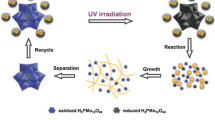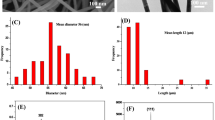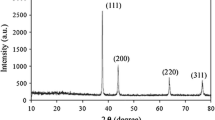Abstract
Silver nanowires have attracted wide research attention for their excellent optical, electrical and chemical properties. Many researches were performed toward synthesizing and application of silver nanowires. The application of silver nanowires such as transparent conductive film electrode, conductive silver adhesive and nanowelding technology was introduced herein. Principles and characteristics of different synthesizing methods of silver nanowires were reviewed in this paper, including template method, liquid polyol method, self-assembly method, ultrasonic reduction method and wet chemical method. The liquid polyol method was the most available one to achieve efficient large-scale production.












Similar content being viewed by others
References
Zhang Z, Li J. Synthesis and characterization of silver nanoparticles by a sonochemical method. Rare Met Mater Eng. 2012;41(10):1700.
Guan M, Shang T, He X, Sun J, Zhou Q, Gu P. Synthesis of silver nanoplates without agitation and surfactant. Rare Met Mater Eng. 2011;40(12):2069.
Jiang X, Yu A. Low dimensional silver nanostructures: synthesis, growth mechanism, properties and applications. J Nanosci Nanotechnol. 2010;10(12):7829.
Hu MJ, Gao JF, Dong YC, Yang SL, Li RKY. Rapid controllable high-concentration synthesis and mutual attachment of silver nanowires. RSC Adv. 2012;2(5):2055.
Shobin LR, Manivannan S. One pot rapid synthesis of silver nanowires using NaCl assisted glycerol mediated polyol process. Electron Mater Lett. 2014;10(6):1027.
Cheng D, Kim WY, Min SK, Nautiyal T, Kim KS. Magic structures and quantum conductance of 110 silver nanowires. Phys Rev Lett. 2006;96(9):096104.
Li Z, Hao F, Huang Y, Fang Y, Nordlander P, Xu H. Directional light emission from propagating surface plasmons of silver nanowires. Nano Lett. 2009;9(12):4383.
Madaria AR, Kumar A, Zhou CW. Large scale, highly conductive and patterned transparent films of silver nanowires on arbitrary substrates and their application in touch screens. Nanotechnology. 2011;22(24):7.
Li Y, Cui P, Wang L, Lee H, Lee K, Lee H. Highly bendable, conductive, and transparent film by an enhanced adhesion of silver nanowires. ACS Appl Mater Interfaces. 2013;5(18):9155.
Jose Andres L, Fe Menendez M, Gomez D, Luisa Martinez A, Bristow N, Paul Kettle J, Menendez A, Ruiz B. Rapid synthesis of ultra-long silver nanowires for tailor-made transparent conductive electrodes: proof of concept in organic solar cells. Nanotechnology. 2015;26(26):265201.
Oh MK, Shin YS, Lee CL, De R, Kang H, Yu NE, Kim BH, Kim JH. Morphological and SERS properties of silver nanorod array films fabricated by oblique thermal evaporation at various substrate temperatures. Nanoscale Res Lett. 2015;10(1):962.
Khlebtsov BN, Khanadeev VA, Maksimova IL, Terentyk GS, Khlebtsov NG. Silver nanocubes and gold nanocages: fabrication, optical and photothermal properties. Russ Nanotechnol. 2010;5(7–8):54.
Xu G, Qiao X, Qiu X, Chen J. Progress in preparation of nano-silver. Materials Rev. 2010;24(11):139.
Zhang Y, Wang J, Yang P. Convenient synthesis of Ag nanowires with tunable length and morphology. Mater Res Bull. 2013;48(2):461.
Zhu G, Chen DP. Solvothermal fabrication of uniform silver nanowires. J Mater Sci Mater Electron. 2012;23(11):2035.
Qu F, Zhang T, Gu HW, Qiu QQ, Ding FZ, Peng XY, Wang HY. Electrical and optical properties of ZnO: Al films with different hydrogen contents in sputtering gas. Rare Met. 2015;34(3):173.
Wu ZC, Chen ZH, Du X, Logan JM, Sippel J, Nikolou M, Kamaras K, Reynolds JR. Transparent, conductive carbon nanotube films. Science. 2004;305(5688):1273.
Watcharotone S, Dikin DA, Stankovich S, Piner R, Jung I, Dommett GHB, Evmenenko G, Wu SE. Graphene-silica composite thin films as transparent conductors. Nano Lett. 2007;7(7):1888.
Hecht DS, Hu L, Irvin G. Emerging transparent electrodes based on thin films of carbon nanotubes, graphene, and metallic nanostructures. Adv Mater. 2011;23(13):1482.
Granqvist CG, Hultaker A. Transparent and conducting ITO films: new developments and applications. Thin Solid Films. 2002;411(1):1.
Harvey SP, Mason TO, Gassenbauer Y, Schafranek R, Klein A. Surface versus bulk electronic/defect structures of transparent conducting oxides: I. Indium oxide and ITO. J Phys D Appl Phys. 2006;39(18):3959.
Ren B, Liu X, Wang M, Xu Y. Preparation and characteristics of indium tin oxide (ITO) thin films at low temperature by r.f. magnetron sputtering. Rare Met. 2006;25(S):137.
Tenent RC, Barnes TM, Bergeson JD, Ferguson AJ, To B, Gedvilas LM, Heben MJ, Blackburn JL. Ultrasmooth, Large-area, high-uniformity, conductive transparent single-walled-carbon-nanotube films for photovoltaics produced by ultrasonic spraying. Adv Mater. 2009;21(31):3210.
Liu Y, Zhang J, Yan J, Du J, Gan G, Yi J. Direct electrodeposition of Fe–Ni alloy films on silicon substrate. Rare Met Mater Eng. 2014;43(12):2966.
He WW, Ye CH. Flexible transparent conductive films on the basis of Ag nanowires: design and applications: a review. J Mater Sci Technol. 2015;31(6):581.
Han T-H, Lee Y, Choi M-R, Woo S-H, Bae S-H, Hong BH, Ahn JH, Lee TW. Extremely efficient flexible organic light-emitting diodes with modified graphene anode. Nat Photonics. 2012;6(2):105.
Wu J, Agrawal M, Becerril HA, Bao Z, Liu Z, Chen Y, Peumans P. Organic light-emitting diodes on solution-processed graphene transparent electrodes. ACS Nano. 2010;4(1):43.
Liu J, Wu G, Li S, Yu M, Yi J, Wu L. Comparative study on chemical stripping of titanium oxide films formed on titanium alloy. Rare Met Mater Eng. 2012;41(8):1331.
Zeng XY, Zhang QK, Yu RM, Lu CZ. A new transparent conductor: silver nanowire film buried at the surface of a transparent polymer. Adv Mater. 2010;22(40):4484.
Yu Z, Zhang Q, Li L, Chen Q, Niu X, Liu J, Pei Q. Highly flexible silver nanowire electrodes for shape-memory polymer light-emitting diodes. Adv Mater. 2011;23(5):664.
Li J, Liang J, Jian X, Hu W, Li J, Pei Q. A flexible and transparent thin film heater based on a silver nanowire/heat-resistant polymer composite. Macromol Mater Eng. 2014;299(11):1403.
Choi HO, Kim DW, Kim SJ, Yang SB, Jung HT. Role of 1D metallic nanowires in polydomain graphene for highly transparent conducting films. Adv Mater. 2014;26(26):4575.
Ye SR, Rathmell AR, Chen ZF, Stewart IE, Wiley BJ. Metal nanowire networks: the next generation of transparent conductors. Adv Mater. 2014;26(39):6670.
Madaria AR, Kumar A, Ishikawa FN, Zhou CW. Uniform, highly conductive, and patterned transparent films of a percolating silver nanowire network on rigid and flexible substrates using a dry transfer technique. Nano Res. 2010;3(8):564.
Lee HS, Kim YW, Kim JE, Yoon SW, Kim TY, Noh JS, Suh KS. Synthesis of dimension-controlled silver nanowires for highly conductive and transparent nanowire films. Acta Mater. 2015;83:84.
Langley DP, Giusti G, Lagrange M, Collins R, Jimenez C, Brechet Y, Bellet D. Silver nanowire networks: physical properties and potential integration in solar cells. Solar Energy Mater Solar Cells. 2014;125(S):318.
Ajuria J, Ugarte I, Cambarau W, Etxebarria I, Tena-Zaera R, Pacios R. Insights on the working principles of flexible and efficient ITO-free organic solar cells based on solution processed Ag nanowire electrodes. Sol Energy Mater Sol Cells. 2012;102:148.
Zhang Q, Vichchulada P, Lay MD. Length, bundle, and density gradients in spin cast single-walled carbon nanotube networks. J Phys Chem C. 2010;114(39):16292.
Guo X, Guo CW, Wang C, Li C, Sun XM. AlGaInP LED with low-speed spin-coating silver nanowires as transparent conductive layer. Nanoscale Res Lett. 2014;9(1):2495.
Liu Y, Zhao X, Cai B, Pei T, Tong Y, Tang Q, Liu Y. Controllable fabrication of oriented micro/nanowire arrays of dibenzo-tetrathiafulvalene by a multiple drop-casting method. Nanoscale. 2014;6(3):1323.
Hu L, Kim HS, Lee JY, Peumans P, Cui Y. Scalable coating and properties of transparent, flexible, silver nanowire electrodes. ACS Nano. 2010;4(5):2955.
Triambulo RE, Cheong H-G, Park J-W. All-solution-processed foldable transparent electrodes of Ag nanowire mesh and metal matrix films for flexible electronics. Org Electron. 2014;15(11):2685.
Lu YC, Chou KS. Tailoring of silver wires and their performance as transparent conductive coatings. Nanotechnology. 2010;21(21):2157.
Chen D, Qiao X, Qiu X, Tan F, Chen J, Jiang R. Effect of silver nanostructures on the resistivity of electrically conductive adhesives composed of silver flakes. J Mater Sci Mater Electron. 2010;21(5):486.
Luo SY, Wang N, Xu WC, Lv Y. Preparation and rheological behavior of lead free silver conducting paste. Mater Chem Phys. 2008;111(1):20.
Zhang X, Lei Y, Zhang Z, Qiu T. Preparation and conductivity of ultrafine silver conductive paste. Chin J Vac Sci Technol. 2014;34(11):1257.
Lu Y, Huang JY, Wang C, Sun S, Lou J. Cold welding of ultrathin gold nanowires. Nat Nanotechnol. 2010;5(3):218.
Chen CX, Yan LJ, Kong ESW, Zhang YF. Ultrasonic nanowelding of carbon nanotubes to metal electrodes. Nanotechnology. 2006;17(9):2192.
Zhao B, Chen C, Yadian B, Liu P, Lu Z, Xu D, Zhang Y. Effects of welding head on the carbon nanotube field emission in ultrasonic nanowelding. Thin Solid Films. 2009;517(6):2012.
Garnett EC, Cai W, Cha JJ, Mahmood F, Connor ST, Christoforo MG, Cui Y, Mcgehee MD, Brongersma ML. Self-limited plasmonic welding of silver nanowire junctions. Nat Mater. 2012;11(3):241.
Giusti G, Langley DP, Lagrange M, Collins R, Jimenez C, Brechet Y. Thermal annealing effects on silver nanowire networks. Int J Nanotechnol. 2014;11(9–11):785.
Vafaei A, Hu A, Goldthorpe IA. Joining of individual silver nanowires via electrical current. Nano-Micro Lett. 2014;6(4):293–300.
Ilie A, Crampin S, Karlsson L, Wilson M. Repair and stabilization in confined nanoscale systems-inorganic nanowires within single-walled carbon nanotubes. Nano Res. 2012;5(12):833.
Ahn KW, Lim JY, Yang JH, Kim SG. In situ growth of silver nanoparticles in mesoporous silica by spray pyrolysis. J Nanopart Res. 2010;12(7):2457.
Sun XY, Xu FQ, Li ZM, Zhang WH. Cyclic voltammetry for the fabrication of high dense silver nanowire arrays with the assistance of AAO template. Mater Chem Phys. 2005;90(1):69.
Han YY, Cao L, Xu FQ, Qian K, Huang WX. Investigations on the thermal weight loss and the photoluminescence mechanism of AAO template. J Inorg Mater. 2012;27(3):305.
Jones MR, Osberg KD, Macfarlane RJ, Langille MR, Mirkin CA. Templated techniques for the synthesis and assembly of plasmonic nanostructures. Chem Rev. 2011;111(6):3736.
Kim TY, Kim WJ, Hong SH, Kim JE, Suh KS. Ionic-liquid-assisted formation of silver nanowires. Angew Chem Int Edit. 2009;48(21):3806.
Sun YG, Mayers B, Herricks T, Xia YN. Polyol synthesis of uniform silver nanowires: a plausible growth mechanism and the supporting evidence. Nano Lett. 2003;3(7):955.
Schuette WM, Buhro WE. Polyol synthesis of silver nanowires by heterogeneous nucleation; mechanistic aspects influencing nanowire diameter and length. Chem Mater. 2014;26(22):6410.
Yan G, Peng J, Li S, Liu LF, Yan X, Zhou Z, Liu D, Wang J. Growth mechanism of silver nanowires synthesized by polyvinylpyrrolidone-assisted polyol reduction. J Phys D (Appl Phys). 2005;38(7):1061.
Sun YG, Yin YD, Mayers BT, Herricks T, Xia YN. Uniform silver nanowires synthesis by reducing AgNO3 with ethylene glycol in the presence of seeds and poly(vinyl pyrrolidone). Chem Mater. 2002;14(11):4736.
Tsuji M, Nishizawa Y, Matsumoto K, Miyamae N, Tsuji T, Zhang X. Rapid synthesis of silver nanostructures by using microwave-polyol method with the assistance of Pt seeds and polyvinylpyrrolidone. Colloids Surf A Physicochem Eng Asp. 2007;293(1–3):185.
Chen DP, Zhu G, Zhu XG, Qiao XL, Chen JG. Controlled synthesis of monodisperse silver nanocubes via a solvothermal method. J Mater Sci Mater Electron. 2011;22(12):1788.
Wiley B, Sun YG, Xia YN. Polyol synthesis of silver nanostructures: control of product morphology with Fe(II) or Fe(III) species. Langmuir. 2005;21(18):8077.
Ma JJ, Zhan MS. Rapid production of silver nanowires based on high concentration of AgNO3 precursor and use of FeCl3 as reaction promoter. RSC Adv. 2014;4(40):21060.
Lee JH, Lee P, Lee D, Lee SS, Ko SH. Large-scale synthesis and characterization of very long silver nanowires via successive multistep growth. Cryst Growth Des. 2012;12(11):5598.
Lee P, Lee J, Lee H, Yeo J, Hong S, Nam KH, Lee D, Lee SS, Ko SH. Highly stretchable and highly conductive metal electrode by very long metal nanowire percolation network. Adv Mater. 2012;24(25):3326.
Liu SH, Sun BM, Li JG, Chen JL. Silver nanowires with rounded ends: ammonium carbonate-mediated polyol synthesis, shape evolution and growth mechanism. CrystEngComm. 2014;16(2):244.
Liu JH, Tsai CY, Chiu YH, Hsieh FM. The fabrication of polycrystalline silver nanowires via self-assembled nanotubesat controlled temperature. Nanotechnology. 2009;20(3):035301.
Liu JH, Hsieh FM. Fabrication of polycrystalline silver nanowires via reversed micelle with amphiphilic diblock copolymer and aluminum oxide template at controlled temperature. Polym Compos. 2010;31(8):1352.
Tsuji M, Matsumoto K, Jiang P, Matsuo R, Tang XL, Karnarudin KSN. Roles of Pt seeds and chloride anions in the preparation of silver nanorods and nanowires by microwave-polyol method. Colloids Surf A Physicochem Eng Asp. 2008;316(1–3):266.
Yang Y, Hu YY, Xiong XH, Qin YZ. Impact of microwave power on the preparation of silver nanowires via a microwave-assisted method. RSC Adv. 2013;3(22):8431.
Ju WG, Zhang XH, Wu SK. Wet chemical synthesis of Ag nanowires array at room temperature. Chem Lett. 2005;34(4):510.
Maddanimath T, Kumar A, D’Arcy-Gall J, Ganesan PG, Vijayamohanan K, Ramanath G. Wet-chemical templateless assembly of metal nanowires from nanoparticles. Chem Commun. 2005;11:1435.
Chen M, Wang C, Wei X, Diao G. Rapid synthesis of silver nanowires and network structures under cuprous oxide nanospheres and application in surface-enhanced Raman scattering. J Phys Chem C. 2013;117(26):13593.
Ngoc-Thang N, Liu JH. Wet chemical synthesis of silver nanowires based on a soft template of cholesteryl pyridine carbamate organogel. Sci Adv Mater. 2015;7(7):1282.
Acknowledgments
This study was financially supported by the National Nature Science Foundation of China (Nos. 51003060 and 51101103), Shenzhen Science and Technology Research Program (Nos. JCYJ20130329105010137 and JCYJ 20150331142303052), and Nanshan District Special Funds (No. FG2013JNYF0015A).
Author information
Authors and Affiliations
Corresponding author
Rights and permissions
About this article
Cite this article
Xiang, XZ., Gong, WY., Kuang, MS. et al. Progress in application and preparation of silver nanowires. Rare Met. 35, 289–298 (2016). https://doi.org/10.1007/s12598-016-0695-6
Received:
Revised:
Accepted:
Published:
Issue Date:
DOI: https://doi.org/10.1007/s12598-016-0695-6




